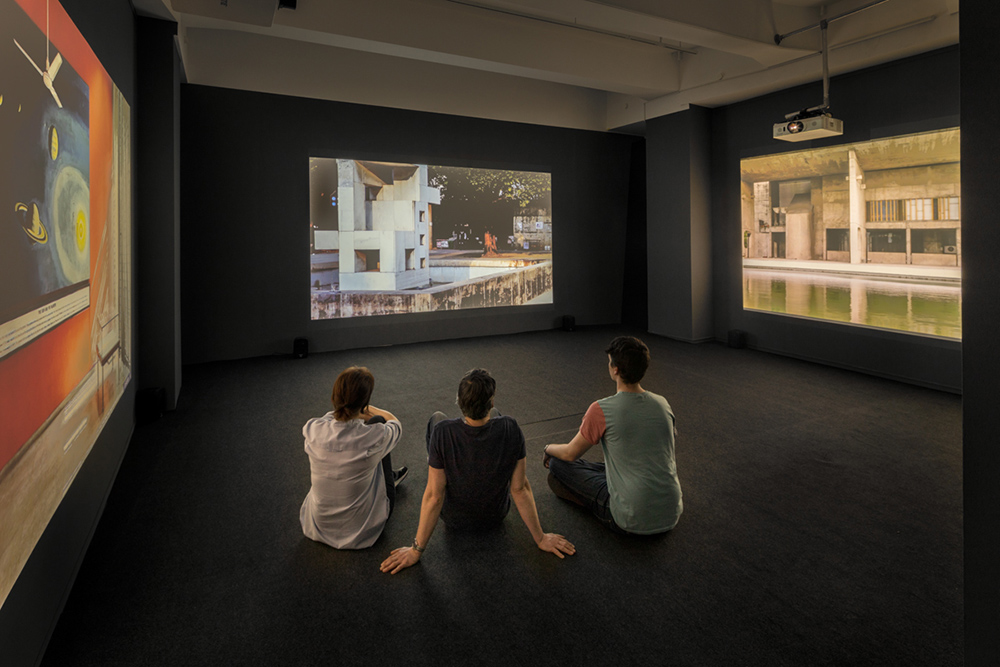


THE BRUTALISM APPRECIATION SOCIETY
HMKV (Hartware MedienKunstVerein), Dortmund (DE)
08.04.2017 – 24.09.2017
Curator:
Inke Arns (DE)
Artists:
Bettina Allamoda (US/DE), Jordi Colomer (ES), Darco FBI (DE/FR), EVOL (DE), Darko Fritz (HR), Anne-Valérie Gasc (FR), Niklas Goldbach (DE),
Freya Hattenberger & Peter Simon (DE/PL), Alekos Hofstetter (DE), Martin Kohout (CZ), Aglaia Konrad (AT/BE), Nicolas Moulin (FR), Reto Müller (CH),
Andrea Pichl (DE), Heidi Specker (DE), Philip Topolovac (DE), Kay Walkowiak (AT), Ruben Woodin Dechamps & Oscar Hudson (UK), Tobias Zielony (DE)
The radical architectural style of Brutalism first emerged in Britain in the mid-1950s. Its hallmarks are unrendered concrete walls and exposed building materials such as metal, stone and brick. Today it is gradually disappearing from our city skylines, as the largely unlisted buildings are pulled down. At the same time, supporters of the style have started coming together – particularly online. Among them is the Facebook group “The Brutalism Appreciation Society”, which campaigns to preserve these features of 1950s and 1960s town planning, and now has more than 50,000 members worldwide.
With his cinematic trilogy, Kay Walkowiak leads us to Chandigarh in India, this planned city designed by Le Corbusier on the drawing board in the 1950s. In long shots, The City Beautiful approaches the various structures realised by Le Corbusier himself, the parliament and the ministry buildings. In the background we hear the regular traffic noises of the metropolitan region and the cheerful chirping of birds. Chandigarh – a city for eternity? The first signs of disintegration are revealed in Body of Concrete. The concrete, once the epitome of modern building, has suffered greatly in past decades under the climatic conditions and the absence of maintenance measures. Nature has also reclaimed its place and taken possession of the architectural icons. Walkowiak‘s Modulor, referring back to Le Corbusier‘s system of proportion for architecture based on the human scale, presents another component of the progressing transformation: the human being. This is because it is of course the residents of Chandigarh that make „their“ city their own, without showing any regard to Le Corbusier‘s architectural legacy.
An exhibition about concrete wouldn‘t be the same without the subject of skateboarding. Fortunately, the Austrian artist Kay Walkowiak also recognised the rich synergies involved in linking high and skating culture, and went on to film Minimal Vandalism. A classic white cube in which minimalist sculptures are exhibited is the first thing seen. This setting reveals itself as a course for the professional Spanish skater Kilian Martin, who lives in California. He masters the space on three skateboards stacked on top of one another and incorporates the sculptures into his impressive skate performance. Walkowiak has documented Martin‘s athletic appropriation of the space in dynamic shot sequences: the skateboarder acrobatically uses the exhibited objects to demonstrate his skills. He slides and grinds over them, pirouettes and transforms the light yellow block into a halfpipe. Macro shots reveal the many scratches, drag marks and metal fragments that the act of vandalism, namely that of relocating the street tricks to the exhibition space, have left behind on the previously so virginal sculptures.
Text: Daniela Ihrig, HMKV, Dortmund 2017
Photos: (c) HMKV
With his cinematic trilogy, Kay Walkowiak leads us to Chandigarh in India, this planned city designed by Le Corbusier on the drawing board in the 1950s. In long shots, The City Beautiful approaches the various structures realised by Le Corbusier himself, the parliament and the ministry buildings. In the background we hear the regular traffic noises of the metropolitan region and the cheerful chirping of birds. Chandigarh – a city for eternity? The first signs of disintegration are revealed in Body of Concrete. The concrete, once the epitome of modern building, has suffered greatly in past decades under the climatic conditions and the absence of maintenance measures. Nature has also reclaimed its place and taken possession of the architectural icons. Walkowiak‘s Modulor, referring back to Le Corbusier‘s system of proportion for architecture based on the human scale, presents another component of the progressing transformation: the human being. This is because it is of course the residents of Chandigarh that make „their“ city their own, without showing any regard to Le Corbusier‘s architectural legacy.
An exhibition about concrete wouldn‘t be the same without the subject of skateboarding. Fortunately, the Austrian artist Kay Walkowiak also recognised the rich synergies involved in linking high and skating culture, and went on to film Minimal Vandalism. A classic white cube in which minimalist sculptures are exhibited is the first thing seen. This setting reveals itself as a course for the professional Spanish skater Kilian Martin, who lives in California. He masters the space on three skateboards stacked on top of one another and incorporates the sculptures into his impressive skate performance. Walkowiak has documented Martin‘s athletic appropriation of the space in dynamic shot sequences: the skateboarder acrobatically uses the exhibited objects to demonstrate his skills. He slides and grinds over them, pirouettes and transforms the light yellow block into a halfpipe. Macro shots reveal the many scratches, drag marks and metal fragments that the act of vandalism, namely that of relocating the street tricks to the exhibition space, have left behind on the previously so virginal sculptures.
Text: Daniela Ihrig, HMKV, Dortmund 2017
Photos: (c) HMKV
︎ Archive Exhibitions